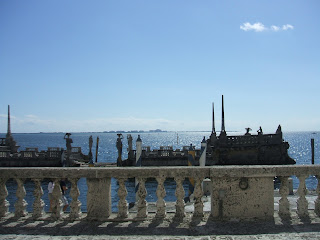A hundred years ago, industrialists with names like Vanderbilt, Deering and Carnegie amassed large fortunes in steel, oil, railroads and machinery. They lived in the Northeast, but created summer castles elsewhere, furnishing them inside with the finest European treasures and Asian curiosities.
They hired renowned landscape architects to surround their dream homes with exquisite gardens using plants from around the world. These vast gardens displayed plant collections, terraces, statuary and fountains that flaunted wealth outside the house just as Old Masters oil paintings and medieval tapestries did inside the house.
Vizcaya was built as a summer house on a bay near Miami by industrialist James Deering, whose family owned International Harvester, a company that made farm equipment. At the time, Miami was a small town of 10,000 people.
The house was designed as an Italian estate that had stood for 400 years. Two stories of rooms opened to a large square courtyard in the middle.
The drive to the house was wide and shady, flanked by tall trees and rectangular pools of water.
The back of the house opened out to Biscayne Bay on the Atlantic Ocean. A limestone Barge with classical statues was used for parties and guests were ferried from the house by gondola. The Barge had a practical function as well, a breakwater against tidal surges during storms.
Vizcaya contains several themed gardens, including the Secret Garden, a sunken garden originally designed to display orchids.
Now the secret garden displays echeveria, tropical succulent plants that survive on little water and require little soil.
A view through lush tropical plants and palms along the perimeter of the garden reveals Biscayne Bay.
Farther from the house, the native vegetation has been left intact, a hardwood hammock that includes the only mangroves left in Miami. Behind these mangroves is the Fountain Garden. The centerpiece was for centuries the only source of water in a small Italian village. When the town upgraded to running water, they needed the space in the center of town for cars and the town sold the fountain to Deering, who brought it to Miami in pieces and reassembled it.
A view back to the house from an elevated island.
Universities are named for industrialists like Vanderbilt, Stanford and Carnegie. We forget how brutal these men were to the people who worked for them, how ruthless to competitors. They did not care for ordinary people, but today, one hundred years later, everyday tourists are the ones who are impressed by these homes and gardens.



























